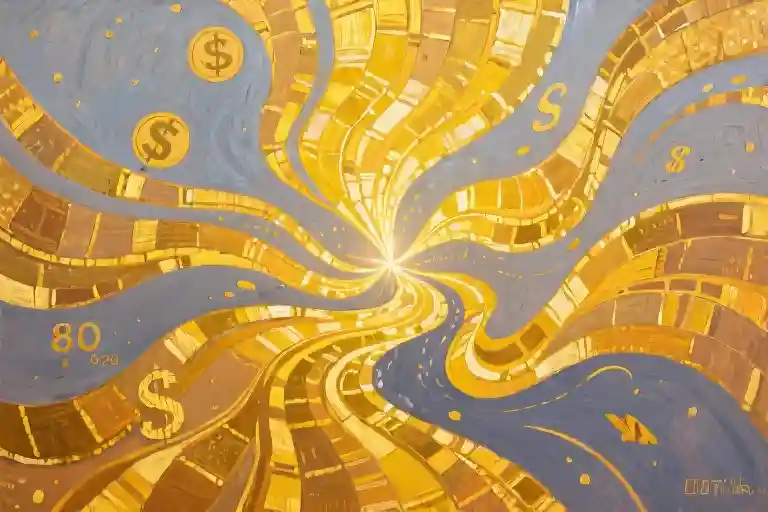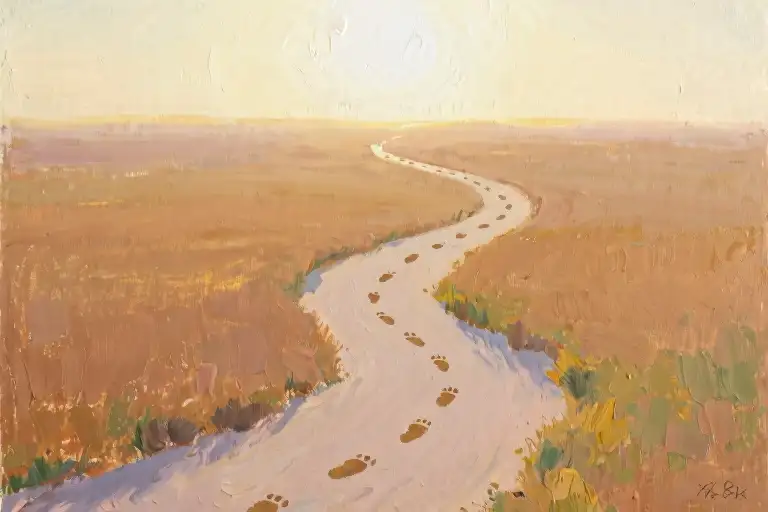The cursor blinks on an empty page. A familiar tightness creeps into your shoulders as you stare at the whiteness stretching before you like an endless desert. Leonard Bernstein’s words echo through the creative drought: “You can sit there, tense and worried, freezing the creative energies, or you can start writing something. It doesn’t matter what.”
Somewhere between his pragmatic advice and the swirling poetry of desert winds lies your current creative crossroads. That heat you feel isn’t just metaphorical—it’s the very real friction of ideas refusing to coalesce, the uncomfortable awareness that your inner compass needle spins wildly without settling on true north.
The test begins with a simple question: What’s currently evaporating your creative oasis?
- Scorching deadlines (Relentless heatwaves of expectation)
- Dried-up inspiration (Parched stretches between ideas)
- Shifting priorities (Dunes rearranging overnight)
- All of the above (Full desert survival mode)
No need to answer aloud. The way your fingers hesitate over the keyboard, the slight dryness in your throat as you consider options—these physical reactions already map your personal creative ecosystem. That faint mirage glimmering in the distance? It’s the ghost of last week’s brilliant concept, now indistinguishable from the heat haze of wishful thinking.
Bernstein’s five-minute promise feels both impossibly short and dauntingly long when you’re mentally stranded without supplies. Yet the alternative—staying frozen in this creative permafrost—leaves your work buried under layers of unmoved sand. The poetry whispers of searing winds because truth burns: creative blocks aren’t passive states, but active erosion.
What makes this moment pivotal isn’t the blankness itself, but your readiness to see it as something other than failure. The desert isn’t your enemy; it’s the testing ground where unnecessary baggage gets left behind. Those aren’t just heatwaves distorting the horizon—they’re the visible pulse of your imagination beginning to stir the air.
The next words you type don’t need to be perfect. They don’t even need to be good. They simply need to exist like the first footprint in untouched sand—proof that motion is possible, that the vastness can be crossed one imperfect step at a time.
Mapping Your Creative Desert
The blank page stares back at you, its whiteness more blinding than the midday sun over endless dunes. That tightening in your chest isn’t just nervousness—it’s the first gust of searing wind across your creative desert. Leonard Bernstein understood this when he observed how creative energies freeze under tension, how simply beginning—regardless of quality—can make the imagination thaw.
Creative deserts manifest differently for each traveler. Some face the dry, cracked earth of stagnation, where every idea seems to crumble to dust before reaching the page. Others battle sandstorms of overthinking, where swirling particles of self-doubt obscure all vision. Then there are those trapped in the endless dunes of perfectionism, walking in circles chasing mirages of ‘good enough.’
Three distinct climate zones emerge in this metaphorical landscape:
The Drought Zone
Characterized by complete creative dehydration. The mind feels barren, devoid of moisture. Every attempt to squeeze out ideas produces only dust. Symptoms include staring at blinking cursors, rewriting the same sentence twelve times, and that particular despair when coffee stops working.
The Sandstorm Belt
Here, ideas exist but whirl chaotically like desert winds. A hundred half-formed concepts collide without cohesion. You might have notebooks filled with fragments that never coalesce, or computer folders labeled ‘Ideas (unfinished)’ dating back three years.
The Mirage Expanse
Most treacherous of all, this area tricks creators with phantom visions. That brilliant concept that evaporates upon closer inspection. The ‘perfect solution’ that dissolves when you try to capture it. These false oases waste more creative energy than true barrenness.
To navigate effectively, we need to chart our personal creative climate. Consider these diagnostic questions:
- When stuck, does your mind feel empty (drought) or overcrowded (sandstorm)?
- Do abandoned projects crumble from lack of substance (drought) or collapse under their own complexity (sandstorm)?
- How often do ideas seem brilliant at midnight but nonsensical at dawn (mirage)?
The desert isn’t punishment—it’s the proving ground where authentic creative voices emerge. Those shifting sands erase conventional paths, forcing us to find our own way. The heat that seems to melt inspiration actually forges stronger creative metal. Even the disorienting winds serve a purpose: they scatter the seeds of unexpected connections.
Before attempting to cross your creative desert, you must first understand its particular ecosystem. What weather patterns dominate your creative work? Where do the dunes pile highest? Which mirages tempt you most frequently? This mapping isn’t academic—it’s survival strategy. The creator who knows they’re prone to sandstorms can pack different mental gear than one facing endless drought.
Your creative footprints matter less than their direction. Even stumbling, uneven steps create a path where none existed. The desert rewards movement—any movement—over perfect stillness. Those first awkward sentences Bernstein recommended aren’t just warm-ups; they’re survival strokes in creative quicksand.
Tomorrow’s oasis exists only because today’s traveler kept walking through the heat. Your current creative desert, however parched, contains the moisture of every idea yet to form. The searing winds that seem to erase your path are actually shaping the dunes that will make your journey distinct.
When Creativity Freezes Over
The moment your fingers hover over the keyboard, that’s when the desert winds start howling. Leonard Bernstein was right about creative work – you can either let the anxiety petrify you, or start moving through the sandstorm. But what exactly happens when our mental compass spins wildly under the heat of deadlines and expectations?
The Neuroscience Behind Creative Paralysis
Modern brain imaging shows creativity isn’t some mystical force – it’s a neurological dance between two key systems. The prefrontal cortex (our inner critic) and the default mode network (our imagination engine) need to achieve perfect balance. During creative blocks, it’s not that we lack ideas; our judgment system literally overrides them. Like a survival mechanism gone haywire, the brain mistakes creative risk for actual danger, flooding us with cortisol instead of dopamine.
This explains why Bernstein’s advice works. Those first ten minutes of forced writing aren’t about quality – they’re neurological warm-up laps. The physical act of typing or scribbling gradually coaxes the prefrontal cortex to stand down, like a wary guard dog finally recognizing its owner. Meanwhile, the default network begins its characteristic “mind-wandering” patterns – those very currents that feel like desert winds actually carry the seeds of solutions.
Three Mirage Traps Every Creator Faces
The poem’s imagery of shifting sands perfectly captures how false inspirations derail us:
- The Single-Solution Mirage
That perfect opening line or design concept you can almost grasp? It’s often a cognitive trap. Real creative breakthroughs rarely come as fully-formed visions. The heat of frustration makes us fixate on phantom solutions instead of exploring multiple pathways. - The Nostalgia Mirage
Remember when ideas flowed effortlessly? Our brains tend to romanticize past creative highs while amplifying current struggles. This distorted comparison creates psychological quicksand – the more we struggle to recreate that magic, the deeper we sink. - The External Validation Mirage
Social media has created particularly vicious creative mirages. That viral post or award-winning project we compare ourselves to? It’s usually someone else’s final draft versus our messy process. Like desert travelers chasing distant shimmering lights, we exhaust ourselves pursuing illusions of what “successful” creativity should look like.
Thawing the Frozen Mind
The solution isn’t to avoid the desert – it’s to become a better navigator. Try this simple reset when creativity freezes:
- Switch Sensory Channels
If stuck visually? Describe the problem aloud. Writer’s block? Doodle the concept. This cross-wiring tricks the brain out of its panic loop. - Embrace ‘Bad’ Ideas
Deliberately generate terrible solutions first. The psychological relief of lowered standards often unclogs the mental pipes. - Create Artificial Constraints
Limit your palette to three colors, write only in questions, use a kitchen timer – these arbitrary rules paradoxically free creativity by narrowing options.
The desert isn’t your enemy. Those searing winds? They’re simply the friction that comes when something new is being born. Tomorrow’s oasis exists precisely where today’s mirage dissolves.
The 10-Minute Sandstorm Writing Method
Creative blocks often feel like being stranded in a desert – the more desperately we search for inspiration, the more elusive it becomes. Leonard Bernstein’s wisdom holds true: the simple act of writing anything can melt the frozen imagination. This three-stage approach turns that insight into actionable steps, using our desert metaphor as both guide and companion.
Stage One: Freewriting Frenzy (Minutes 0-3)
Set a timer for three minutes and write without stopping. Let the words flow like desert winds – uncontrolled, directionless, messy. This isn’t about crafting perfect sentences; it’s about shaking loose the mental sand dunes. If stuck, literally write “I’m stuck in this damn creative desert” until new words emerge. The neurological magic happens when we bypass the inner critic and let the prefrontal cortex take a backseat.
Stage Two: Image Hunting (Minutes 3-7)
Now scan your freewriting for any striking images or phrases, like spotting distant palm trees on the horizon. Underline these potential oases. One writer discovered her novel’s climax by noticing the phrase “the sand stung like betrayal” buried in her messy freewrite. These raw images carry more creative voltage than polished ideas because they emerge from the subconscious.
Stage Three: Metaphor Cultivation (Minutes 7-10)
Select one promising image and develop it into a full metaphor. If you wrote about “cracked earth,” explore how that relates to your project. A graphic designer used this method to breakthrough by comparing his creative block to a desert canyon – realizing he needed to stop looking for bridges and instead descend into the depths of his concept.
Desert Survival Kit:
- Hourglass Timer: The physical act of flipping it triggers a ritual mindset
- Sand-Colored Paper: Visual cues reinforce the metaphor’s power
- Mirage Journal: Record false starts to recognize their patterns
- Canteen Notes: Keep voice memos for when writing feels impossible
Try it now – your blank page awaits like untouched desert sands. Remember, even Lawrence of Arabia started with a single footprint.
Case Studies: Oasis Finders’ Chronicles
The blank page often feels like an endless desert – until we discover those who’ve left trails in the sand. Here are documented journeys through creative droughts, complete with their survival tools and discovered oases.
The Novelist’s Footprint Method
Examine the marked-up manuscript pages of novelist Elias Carter, who spent 47 days paralyzed by his dystopian trilogy’s second act. His breakthrough came through what he now calls ‘tracking fictional footprints’ – a process visible in his marginal notes:
Page 23 Draft 4 (circled in red):
“This desert scene feels forced – my characters are walking in circles. Where are their REAL footprints?”
Margin annotation:
“Instead of plotting their path, followed where THEY wanted to go. Let protagonist remember childhood well-digging (unplanned detail) → became water source metaphor for entire chapter.”
His method distilled:
- Identify where writing feels like “walking in circles” (artificial plot points)
- Hunt for organic “footprints” (unplanned character behaviors/descriptions)
- Trust that these lead to hidden “water sources” (thematic depth)
The Designer’s Mirage Journal
Graphic designer Priya Kapoor’s sketchbook reveals her six-week struggle with a rebranding project. Flipping through dated entries shows her developing what she terms “mirage detection” skills:
April 12 (accompanied by desert sunset doodle):
“Client wants ‘innovative but familiar’ – classic mirage. Chasing stock imagery of oases all morning. Dead end.”
April 14 (with collaged magazine clippings):
“Realized: True mirages aren’t fake water, but distortions of REAL water elsewhere. Started mapping client’s actual history instead of competitors’ successes.”
Her breakthrough came by:
- Documenting every “promising idea” that later evaporated
- Noting physical sensations during false inspiration (“tight shoulders, rushed breathing”)
- Creating a “mirage archive” of abandoned directions as reference
These chronicles prove creative breakthroughs aren’t about sudden inspiration, but learning to read the desert’s signs. As Carter notes in his final margin: “The footprints were always there – I just needed to stop making my own windstorms.”
Where the Searing Winds Lead
The unfinished poem lingers like a desert horizon—both promise and warning. That truncated final line (‘the vastness of life’s…’) isn’t an oversight; it’s an invitation. Every creator knows this suspended state, where projects trail off into dunes and compass needles spin wildly. Bernstein’s advice still hums beneath the poetry: movement generates direction, not the other way around.
The Philosophy of Unfinished Journeys
Creative work thrives on incompleteness. Those ellipses after ‘life’s’ mirror the essential truth—we create not to arrive, but to witness the vastness. The desert metaphor holds particular wisdom here: nomads don’t curse the shifting sands; they learn to read new patterns. When your latest draft or sketch feels stranded, consider that the very lack of footprints might signal uncharted territory rather than failure.
This perspective shift aligns with recent flow state research. Psychologists at Berkeley found that the brain’s default mode network activates most powerfully when we embrace uncertainty. The poems’ ‘shattered compass’ could be reframed as a neurobiological gift—disorientation preceding innovation.
The 72-Hour Sandstorm Challenge
Practical application anchors philosophy. Try this three-day framework to harness your creative disquiet:
Day 1: Surrender to the Winds
- Set a timer for 72 minutes (symbolizing hours)
- Write/design/compose using only the poem’s unfinished lines as prompts
- Forbid all editing—let the drafts pile up like desert sediment
Day 2: Map Mirage from Oasis
- Review yesterday’s output with a highlighter
- Mark every instance where anxiety (‘confusion’, ‘entangle’) birthed unexpected beauty
- These intersections become your personal creativity waypoints
Day 3: Pack Light for the Vastness
- Select one fragment that both terrifies and excites you
- Develop it for 72 minutes without a predefined outcome
- The goal isn’t completion but sustained movement through uncertainty
The Invitation in the Dust
Creative blocks often stem from what linguists call ‘the tyranny of the finished thought.’ We’ve been conditioned to believe ideas must arrive fully formed, like Athena springing from Zeus’s head. The desert teaches otherwise—meaning emerges gradually, shaped by persistent winds.
Leave the last line open as the poem does. Tape this prompt above your workspace:
“This desert wind carries traces of __“
Fill the blank with whatever comes—nonsense syllables, half-remembered quotes, grocery lists. Over weeks, these fragments will reveal their own ecology, proving Bernstein right once more: the very act of moving through creative drought creates invisible paths. The searing winds aren’t obstacles; they’re the landscape itself.






This is a topic close to my heart cheers, where are your contact details though?